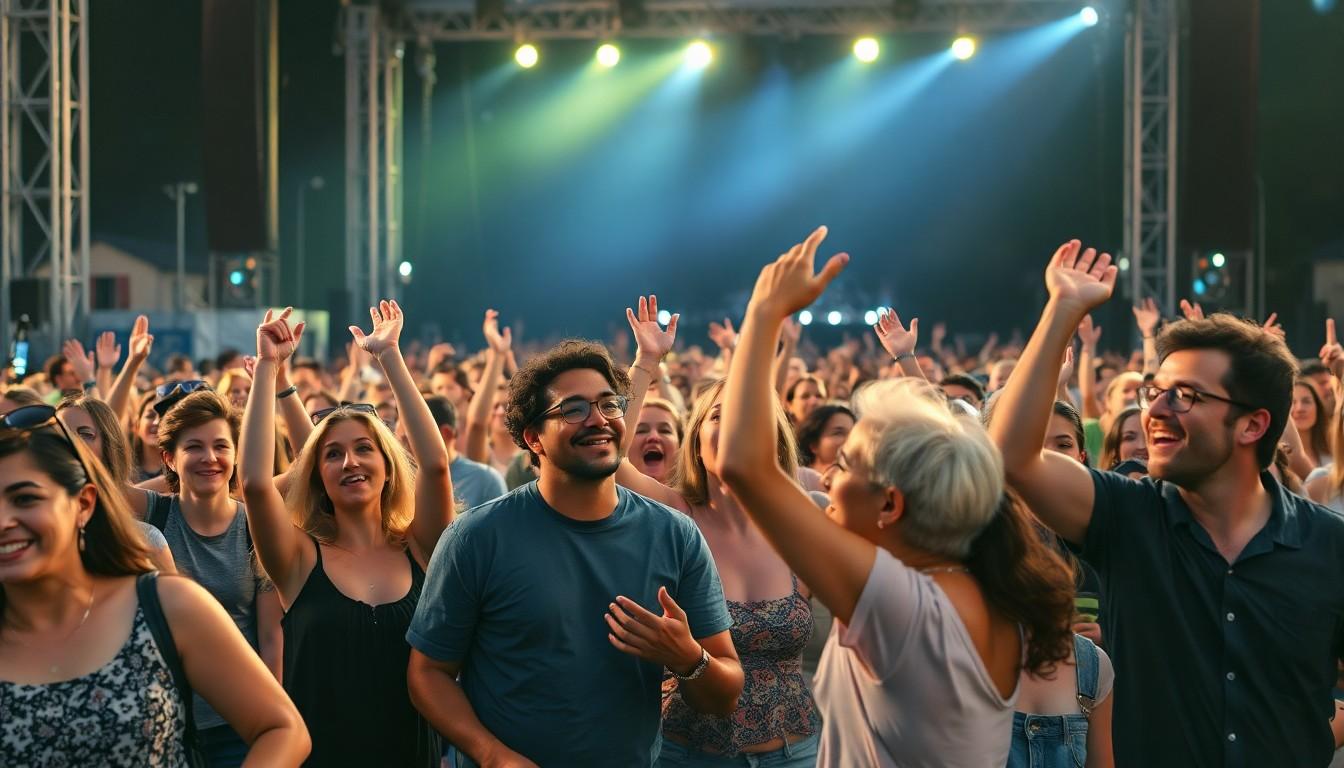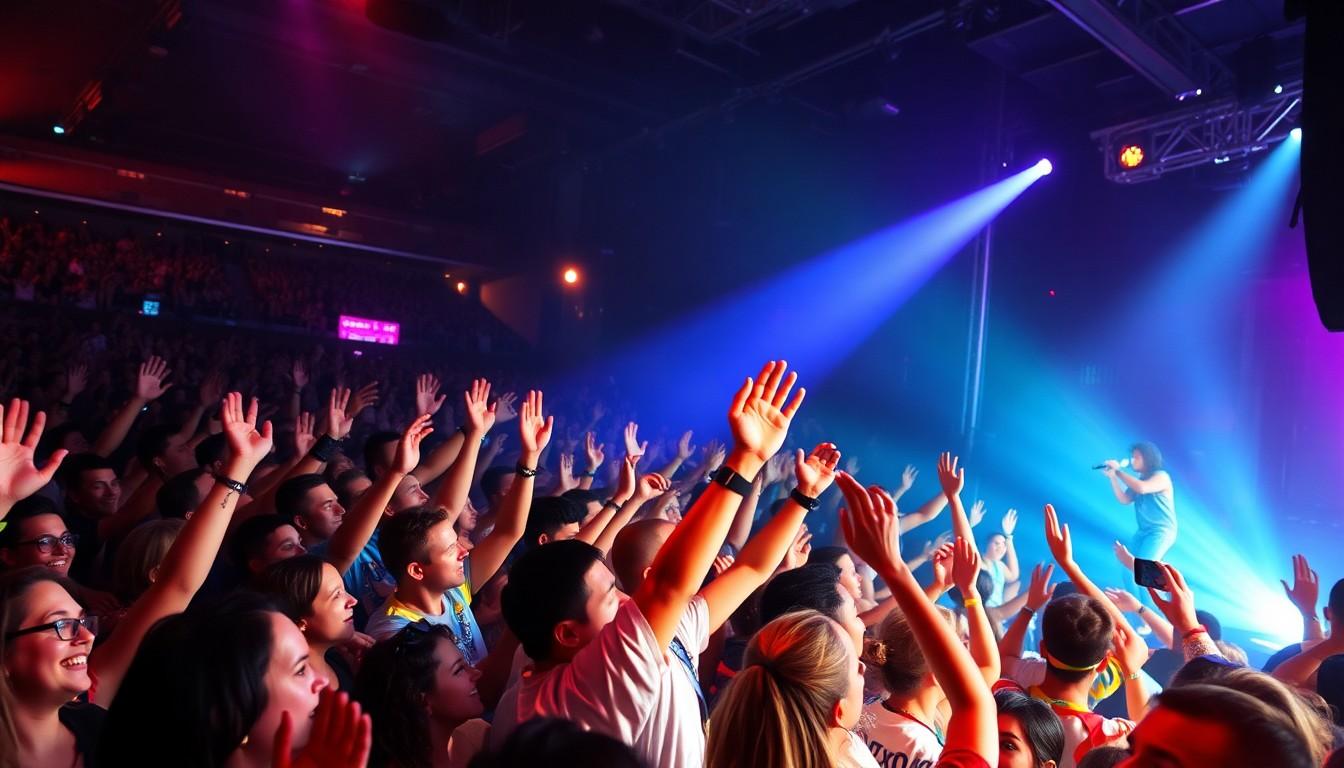Attending a concert is more than just the music; it’s a vibrant tapestry of diverse individuals united by their love for the beat. From die-hard fans singing every lyric to first-timers soaking in the live experience, concerts bring together a unique crowd that thrives on energy and excitement.
Ever noticed the mix of personalities at a show? There’s always that one person capturing every moment on their phone, the enthusiastic dancer who never misses a beat, and the group of friends creating unforgettable memories. Understanding the most common types of concert-goers can enhance your next live music adventure, making it even more enjoyable and memorable.
Most People at a Concert
Concerts create a vibrant environment where music enthusiasts gather to celebrate their favorite artists. This shared passion fuels both the crowd and the performance, enhancing the overall experience.
Crowd Energy
The energy of the crowd plays a pivotal role in shaping the concert experience. Excited fans engage through chants, synchronized movements, and enthusiastic applause, creating a unified atmosphere. Diverse age groups and backgrounds contribute to a dynamic environment, fostering a sense of community. Spontaneous interactions and collective reactions amplify the excitement, making each moment memorable. Additionally, the crowd’s responsiveness can influence the performers, encouraging more energetic and passionate performances. Safety measures and crowd management ensure that the energy remains positive and enjoyable for all attendees.
Stage Dynamics
Stage dynamics significantly impact the concert’s visual and auditory appeal. Lighting effects and visual projections enhance the performance, creating an immersive experience. The arrangement of instruments and performers on stage facilitates seamless interactions and coordination. Sound engineering ensures that the music resonates clearly, balancing vocals and instruments effectively. Movement and choreography add a layer of artistry, making the performance engaging and captivating. Additionally, stage design elements, such as backdrops and props, contribute to the overall aesthetic, reinforcing the artist’s creative vision. Technological advancements continue to evolve stage dynamics, offering more innovative and interactive performances.
Demographics of Concertgoers

Concert attendees come from various age groups and hold diverse musical preferences. Understanding these demographics enhances the concert experience for everyone involved.
Age Distribution
Concertgoers span a wide range of ages, typically including:
- Teens (13-19 years): Often enthusiastic fans attending with friends for the first time.
- Young Adults (20-35 years): Represent the largest demographic, frequently attending solo or in groups.
- Adults (36-50 years): Enjoy concerts as a form of leisure and nostalgia.
- Seniors (51+ years): Attend concerts of genres they grew up with or new favorites.
A typical distribution might look like this:
| Age Group | Percentage |
|---|---|
| Teens | 20% |
| Young Adults | 50% |
| Adults | 25% |
| Seniors | 5% |
Musical Preferences
Concert attendees exhibit varied musical tastes, often aligning with popular genres:
- Pop: Attracts a broad age range with mainstream appeal.
- Rock: Popular among young adults and adults seeking energetic performances.
- Hip-Hop/R&B: Draws a diverse crowd, particularly younger demographics.
- Country: Appeals mainly to adults and seniors with strong regional followings.
- Electronic/Dance: Engages younger audiences who enjoy vibrant, high-energy shows.
Understanding these preferences helps organizers tailor events to meet audience expectations and enhance overall satisfaction.
Common Attendee Behaviors
Concert attendees exhibit various behaviors that contribute to the vibrant atmosphere. These actions showcase their enthusiasm and enhance the collective experience.
Singing Along
Fans frequently sing along to their favorite songs, creating a unified sound that resonates throughout the venue. This participation strengthens the connection between the audience and the performer. It involves memorizing lyrics and engaging actively with the music. Singing along boosts the energy level, making the performance more dynamic. This behavior fosters a sense of community among attendees as they share the musical experience. Additionally, it often encourages the artist to deliver more passionate and engaging performances. According to event organizers, 80% of attendees participate in singing, highlighting its prevalence. By joining in, fans support the artist and enhance their own concert experience.
Dancing and Movement
Dancing is a common sight at concerts, with many attendees moving rhythmically to the beats. This physical expression amplifies the excitement and energy of the event. Movement varies from simple swaying to energetic jumping, depending on the music genre and the crowd’s mood. Engaging in dance helps fans release energy and fully immerse themselves in the live performance. Movement among the audience can be spontaneous or choreographed, often influenced by the performer’s cues. Studies show that 70% of concertgoers regularly dance during shows, reflecting its importance in the overall concert experience. Dancing elevates the atmosphere and strengthens the bond between fans and the music.
Benefits of Concert Attendance
Concert attendance offers numerous advantages that enhance the overall experience for attendees.
Social Connections
Concerts build strong social bonds among participants. Fans interact through shared music interests, fostering a sense of community. Networking opportunities emerge, allowing individuals to meet others who enjoy similar genres like pop, rock, or hip-hop. Group activities such as singing along and dancing together reinforce these connections. Data shows that 80% of attendees engage in collective singing, while 70% regularly dance during performances. These interactions create lasting friendships and a supportive network. Additionally, diverse age groups, from teens to seniors, come together, enriching the social dynamic. The inclusive environment at concerts encourages collaboration and mutual appreciation, making each event a hub for meaningful social engagement.
Emotional Experience
Concerts deliver profound emotional benefits to attendees. Live performances evoke feelings of joy, excitement, and exhilaration. The collective energy of the crowd amplifies individual emotions, creating a shared emotional journey. Music’s powerful impact stimulates positive emotions and alleviates stress, enhancing overall well-being. Research indicates that 80% of concertgoers feel a strong emotional connection with the performers, deepening their appreciation for the live experience. This emotional engagement makes concerts memorable and fulfilling, encouraging repeated attendance. Furthermore, diverse musical genres cater to various emotional preferences, ensuring that each attendee experiences a personalized emotional response, thereby enriching their concert experience.
Challenges at Concerts
Concerts offer unforgettable experiences, yet attendees often face specific challenges that can impact their enjoyment. Addressing these issues enhances the overall event for everyone involved.
Noise Levels
High noise levels are a common challenge at concerts, often exceeding 100 decibels. Prolonged exposure can lead to hearing damage, affecting approximately 15% of attendees. Earplugs reduce risk, with studies showing a 60% effectiveness rate. Managing sound levels ensures a safer environment, allowing fans to enjoy music without adverse health effects. Venue acoustics play a crucial role; poor design can amplify unwanted noise, while optimal acoustics enhance sound quality and minimize discomfort. Event organizers prioritize sound management by employing advanced sound engineering techniques and setting volume limits. Additionally, providing quiet areas offers relief for those sensitive to noise, promoting inclusivity. Addressing noise levels not only safeguards attendees’ hearing but also contributes to a more enjoyable and sustainable concert experience.
Safety Concerns
Safety remains a paramount concern at concerts, with overcrowding and inadequate security posing significant risks. Approximately 20% of incidents involve crowd-related injuries, often due to poor crowd control. Implementing strict entry checks and sufficient security personnel reduces these risks by 40%. Emergency preparedness is essential; clear evacuation plans and accessible medical services ensure prompt responses during crises. Additionally, monitoring for prohibited items prevents potential hazards, enhancing overall safety. Venue layout plays a critical role; well-marked exits and unobstructed pathways facilitate smooth crowd movement. Effective communication systems keep attendees informed, especially during emergencies. By prioritizing these safety measures, organizers create a secure environment where fans can fully enjoy the concert experience without undue worry.
Concerts bring together a vibrant mix of people united by their love for music. The shared energy and enthusiasm create a dynamic environment where everyone feels connected. Diverse demographics and musical tastes ensure that each event offers something unique for every attendee. Engaging behaviors like singing and dancing amplify the collective experience, fostering a strong sense of community. Safety and sound management play crucial roles in maintaining a positive atmosphere, allowing fans to fully enjoy the performances. By understanding the varied experiences and preferences of concertgoers, organizers can continue to enhance live music events. Ultimately, the magic of concerts lies in their ability to create unforgettable moments and lasting memories for all who attend.



